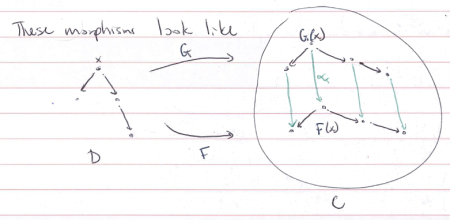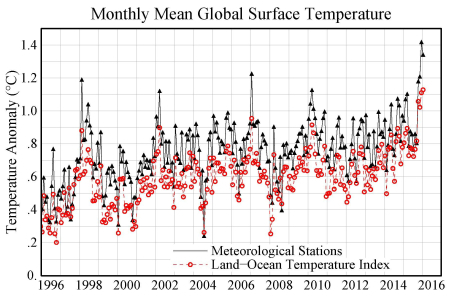John C. Baez's Blog, page 74
March 14, 2016
Network Calculus
If anyone here can go to this talk and report back, I’d be most grateful! I just heard about it from Jamie Vicary.
• Jens Schmitt, Network calculus, Thursday 17 March 2016, 10:00 am, Tony Hoare Room, Robert Hooke Building, the University of Oxford.
Abstract. This talk is about Network Calculus: a recent methodology to provide performance guarantees in concurrent programs, digital circuits, and communication networks. There is a deterministic and a stochastic version of network calculus, prov...
March 11, 2016
Category Theory Course Notes

My grad students and I have been using a lot of category theory in our work on networks in engineering, chemistry and biology. So I decided to teach an introductory course on category theory, and it was surprisingly popular: 25 grad students registered for it! Clearly there’s a lot of interest in the subject, and we don’t regularly teach a course on it at U. C. Riverside.
Here are the notes from my course. In my earlier fall Fall 2015 seminar, I had tried to explain how category theory unifi...
March 7, 2016
The Case for Optimism on Climate Change
The video here is quite gripping: you should watch it!
Despite the title, Gore starts with a long and terrifying account of what climate change is doing. So what’s his case for optimism? A lot of it concerns solar power, though he also mentions nuclear power:
So the answer to the first question, “Must we change?” is yes, we have to change. Second question, “Can we change?” This is the exciting news! The best projections in the world 16 years ago were that by 2010, the world would be able t...
March 5, 2016
The Capricornoid

This curve is called a capricornoid, because it’s supposed to resemble the sign of Capricorn in the zodiac, though I don’t see how. Its equation is

so it’s described by a quartic equation in two variables.
What makes this curve fun is that it has two different kinds of singularities. At the point

it has a tacnode, meaning that two different branches of the curve are tangent at that point. More precisely, two different circles kiss the curve at that point.
Further up, at the point

there is...
March 3, 2016
Global Temperature Spike

Last month Earth’s temperature soared to a record high. This graph, which only goes up to January, shows how much higher the Earth’s surface temperature is than the 1951-1980 average. It’s updated each month by the Goddard Institute of Space Studies, and it’s called GISTEMP. As you can see, we’re currently experiencing a huge spike in temperatures! It has not abated since January: it’s gotten bigger.
GISTEMP relies heavily on meteorological stations. Upper atmosphere temperatures measured b...
February 29, 2016
The Price of Everything
I’m wondering whether anyone has attempted to compute the value of the whole Universe, in dollars.
This strikes me as a crazy idea—a kind of reductio ad absurdum of the economist’s worldview. But people have come pretty close, so I figure it’s just a matter of time. We might as well try it now.
Let me explain.
The price of the EarthThere’s a trend toward trying to estimate the value of ‘ecosystem services’, which means ‘the benefits of nature to households, communities, and economies’. The...
February 26, 2016
Arctic Melting — 2016
According to this graph on the US National Snow and Ice Data Center’s website, there were 14.2 million square kilometers of Arctic sea ice on 24 February 2016. On an average year over the last three decades, it would take until about 29 April for there to be this little Arctic sea ice.
Since about 10 February, the extent of Arctic sea ice has been noticeably below any of the last 30 years. The Arctic has experienced record-breaking temperatures of about 4 C higher than the 1951–1980 average....
February 24, 2016
Hard X-Ray Burst
I just learned something cool: 0.4 seconds after LIGO saw those gravitational waves on 14 September 2015, a satellite named Fermi detected a burst of X-rays!
• V. Connaughton et al, Fermi GBM observations of LIGO gravitational wave event GW150914.
It lasted one second. It was rather weak (for such things). The photons emitted were about 50 kilo-electron volts in energy. That’s close to gamma rays, but not quite. Gamma rays officially have an energy of 100 keV or more, so this radiation is ca...
Gamma Ray Burst
I just learned something cool: 0.4 seconds after LIGO saw those gravitational waves on 14 September 2015, a satellite named Fermi detected a burst of gamma rays!
• V. Connaughton et al, Fermi GBM observations of LIGO gravitational wave event GW150914.
It was rather weak (for such things). It does not appear connected with other previously known objects. It’s hard to tell exactly where it happened. But its location is consistent with what little we know about the source of the gravitational w...
February 12, 2016
The Quagga

The quagga was a subspecies of zebra found only in South Africa’s Western Cape region. After the Dutch invaded, they hunted the quagga to extinction. While some were taken to zoos in Europe, breeding programs failed. The last wild quagga died in 1878, and the very last quagga died in an Amsterdam zoo in 1883.
Only one was ever photographed—the mare shown above, in London. Only 23 stuffed and mounted quagga specimens exist. There was one more, but it was destroyed in Königsberg, Germany, d...
John C. Baez's Blog
- John C. Baez's profile
- 29 followers





